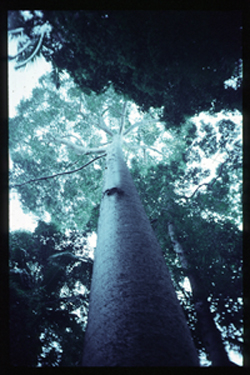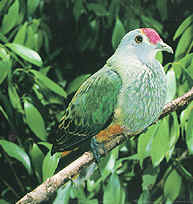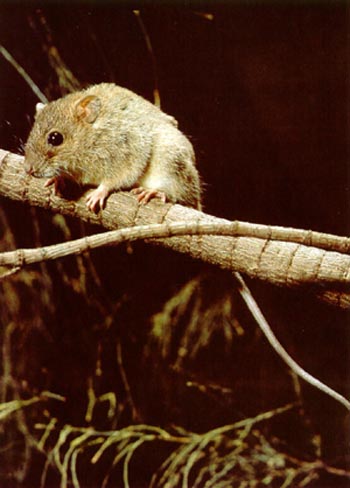Seed Dispersal in Australian Subtropical Rainforest

35 m canopy emergent of Agathis robusta
Fleshy-fruit
Plant seeds usually display some sort of modification to improve how well they disperse when they fall off or are removed from a parent plant. Such modifications might be directed toward increasing the distance the seed is blown by wind (anemochory). Familiar examples of this might be the 'helicopter-like' seeds of maple trees blowing through the sky on an autumn day or the gossimer parachutes of dandelion seeds. While such wind-dispersal adaptations are common in temperate zones, the vast majority of plants in tropical forests have seed morphologies adapted for dispersal by animals (zoochory).

The Rose-crowned Fruit-dove (Ptilinopus
regina). This species is an obligately frugivorous pigeon found in
forests of Australia, New Guinea, and some souhwestern Pacific
archipelagos.
Why Zoochory?
There are a number of reasons why dispersal by animals might be particularly advantageous. First, seeds might require consumption by an animal to 'scarify' the seed coat and otherwise remove germination-inhibiting compounds. One of the first suggestions that passage through the gut of an animal was necessary for a seed to germinate was the publication by Temple (1977) on Calvaria major an extremely endangered tree on Mauritius. Temple surveyed the population of this tree and found that extremely few adults of the species survived with no juveniles recruiting. Trees were producing seeds but seeds were never germinating. He hypothesized that Dodo (Raphus cucullatus), extinct since the 1600's may have once fed on the seeds and that the tree's seeds now required scarification in a bird's gut to germinate. Since Dodo's were no longer available, he tested this theory by feeding seeds to domestic turkeys. Passed seeds germinated, providing the first recruits to the population recorded.

Dodo (Raphus cucullatus) an extinct pigeon from
Mauritius that provided seed scarification for a now-endangered endemic plant.
Seed Predation
However, there are more likely benefits of vertebrate seed dispersal. The seeds of most plant species are attacked by invertebrate or vertebrate seed predators that can destroy the vast majority of seeds a plant might ever produce. Because predators often cue in on the adult plants to find seeds, or the high densities of seeds near adult plants predators tend to destroy a greater percentage of those seeds dropped near adult trees. Consumption and movement of seeds by animals increases the chance that seeds will be deposited in a location more isolated from seed predators.
 The Fawn-footed Melomys (Melomys cervenipes)
is a common native rodent found in the subtropical forests where I
worked. This species was responsible for destroying up to 90% of
the seeds of some plant species I studied.
The Fawn-footed Melomys (Melomys cervenipes)
is a common native rodent found in the subtropical forests where I
worked. This species was responsible for destroying up to 90% of
the seeds of some plant species I studied.
Another benefit of dispersal by vertebrates is that animals may be relatively more effective at depositing seeds in microhabitats that are particularly suitable for germination or establishment. Most of the evidence for this hypotheis comes from work in the tropics on gap-dependent plant species. These are plants that require relatively high light levels to mature and so are principally found in the canopy gaps created when mature trees of any species die, and fall creating light-rich openings in the forest.
Perhaps the best example of this is that documented by Wenny and Levy (1998) in Central America. They found that lekking males of a frugivorous bellbird species displayed mostly in forest gaps (80-90 % of total time). Because they would move through the forest to preferentially feed on certain species and then return to display in forest gaps, they deposited large numbers of seeds in gaps. This particularly benefited some gap-dependent plant species (such as Ocotea tenera, Lauraceae) whose seeds survived and germinated at a much higher rate here than at random locations in the continuous forest.